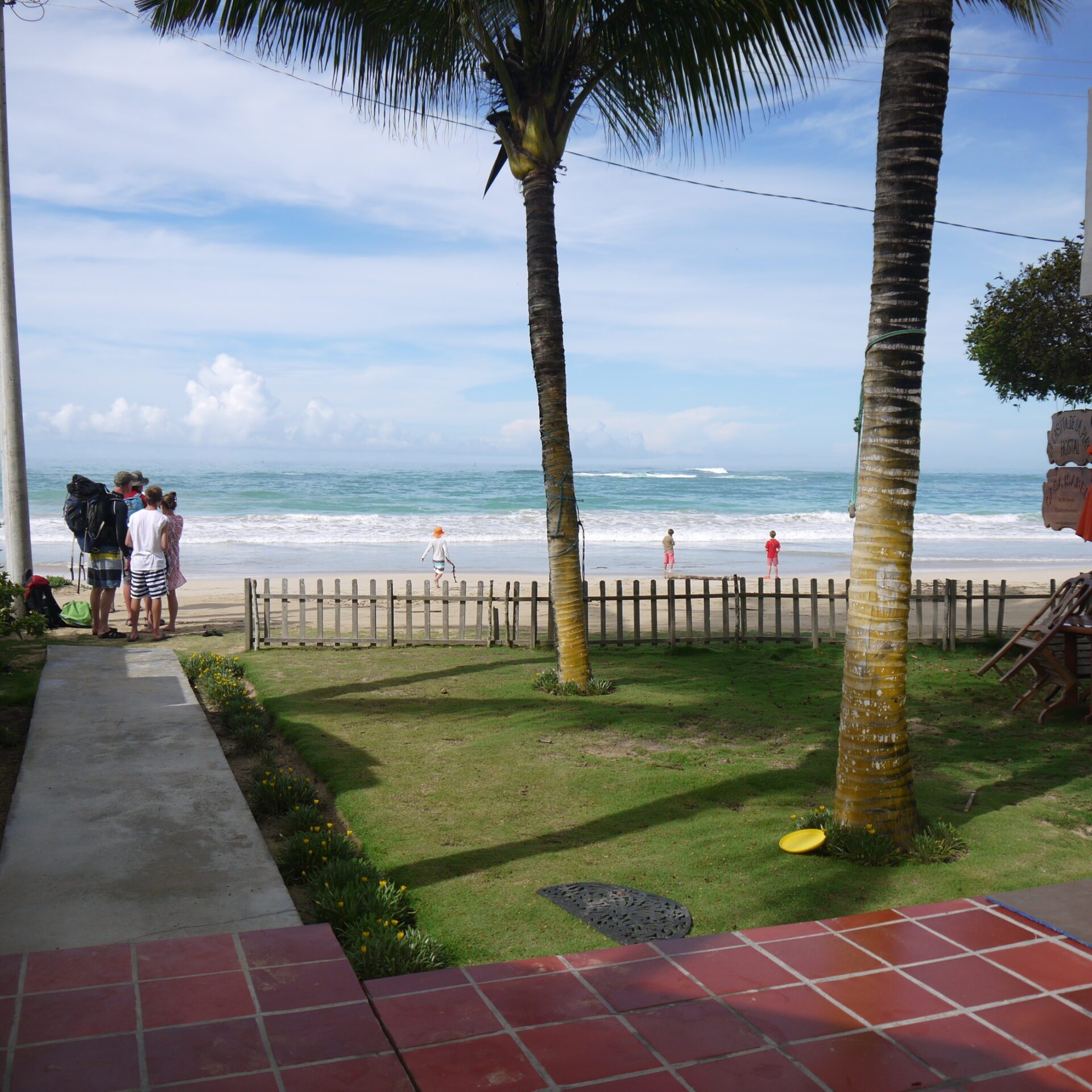Galapagos Islands: Guide to the Best Beaches.
 by Tom Shearman on 30th November, 2021
by Tom Shearman on 30th November, 2021

Galapagos Islands beaches are a traveller’s dream. There are white sand beaches (and other colours!), warm weather, and very few other people to be found on most Galapagos beaches.
Jump into the crystalline waters, and you could be snorkelling with sea lions, sea turtles, manta rays, and more. Or watch the wildlife from the shore, where iguanas, blue-footed boobies, and cute lava lizards roam, unafraid of humans.
The Galapagos National Park affords Galapagos beaches extra protection, maintaining their pristine and untouched feel. It can be tricky to rate the best beaches in Galapagos simply because they all offer unique experiences, from sunbathing to surfing to birdwatching.

The Best Galapagos Beaches to Visit
Many Galapagos beaches can only be reached by boat, adding to their seclusion, protection, and beauty. There are plenty of beautiful beaches accessible on foot, without guides, some of which are a stone’s throw from your hotel room, perfect for families.
Galapagos Islands beaches come in many different shapes, colours and across all the visitable islands. Our guide to the best beaches in Galapagos will help you decide which you simply must visit, be it on a cruise, land-based trip, or an island-hopping trip we can help design.
Remember: Almost all Galapagos beaches have no facilities so you’ll need to take everything with you. This includes plenty of drinking water, food, snacks, sun cream, towels, and any snorkel/kayak/surf kits. Organised trips often include some of these items.
Caution: Beaches have no lifeguards. There are strong sea currents at some sites. Always check with locals about conditions. If in any doubt, book an organised tour or hire a local guide.

Tortuga Bay Galapagos Beach, Santa Cruz Island
Puerto Ayora on Santa Cruz island is one place almost all travellers to Galapagos will see. It’s the largest town in Galapagos and many trips pass through.
The visit to Tortuga Bay starts in Puerto Ayora. Once you check-in at the national park entrance, you enter a pristine environment with no shops or refreshments. Tortuga Bay is a 30 to 45-minute walk (1.5 miles, 2.5km) from the centre along a winding path. Keep an eye out for warblers, finches and mockingbirds. Alternatively, take a 10-minute water taxi from Puerto Ayora.
Your reward is a beautiful, south-facing beach from which you can surf or kayak among marine iguanas, flamingoes and pelicans. The beach takes its name from the turtles (tortugas) that nest there. Swimmers and snorkellers need to jump in the water at the nearby sheltered cove because the currents are too strong at the main beach.

Playa de los Alemanes, Galapagos Beach, Santa Cruz Island
Playa de Los Alemanes, or the German beach, takes its name from German settlers that lived in the area. This beautiful cove is also known as La Playa de Punta Estrada and is next to the Finch Bay Hotel.
This beach is great for kids and families. Calm, crystal clear waters await those who take the short water taxi ride to the Angermeyer jetty in Puerto Ayora then walk five minutes. The beach is surrounded by four types of mangrove trees, and the transparent water is home to rays, turtles, and colourful fish.
Playa de Los Alemanes is popular with locals and suitable for snorkelling, sunbathing, and birdwatching. Cruises don’t stop here, so visit while staying in Puerto Ayora.

El Garrapatero, Galapagos Beach, Santa Cruz Island
Santa Cruz is home to some gorgeous beaches, of which El Garrapatero is one. This secluded, three-kilometre stretch of golden sand is one you may well get to yourself midweek. Apart from the sea lions, flamingoes and blue-footed boobies, that is.
Snorkelling is fantastic here, with many colourful fish and sea turtles often lurking in the tidal pools. Galapagos penguins are also known to occasionally frequent the area.
It’s a 30-minute taxi ride from Puerto Ayora to El Garrapatero. There are no facilities, so take everything you need with you, including lots of water, sun cream, food, and some walking shoes for the hike down to the beach.
Bartolome Island Beach, Bartolome
The unpopulated Bartolome Island is in the middle of the Galapagos archipelago, nestled next to Santiago Island. It is famous for its views of at least ten other Galapagos Islands. It’s also home to one of the best beaches in the Galapagos Islands.
The emblematic Pinnacle Rock, a shard of rock protruding from the sea, towers above beautiful white sand beaches. Under its shadow, sea turtles, penguins, and playful sea lions await visitors. Rays and sharks swim in the shallow waters while hawks and finches abound.
Bartolome forms part of many cruise ship itineraries and can be visited on a day trip from Santa Cruz.

Red Beach, Rabida Island Galapagos Beach
Tired of white sand beaches in the Galapagos? Lying to the south of Santiago Island is Rabida Island with its stunning red beach, the result of oxidised iron-rich volcanic matter.
There is a short hike for beautiful views over the island and the red beach. Some tours include this walk; others spend more time snorkelling in the crystal clear waters. Peer below the waterline, and you may see sharks patrolling the depths, a fantastic sight. Sea lions may join you for a splash about, while on land, blue-footed boobies, brown pelicans and finches can be spotted.
Rabida Island’s red beach is only accessible via Galapagos cruises.

Black Beach, James Bay, Santiago Island
The white and red sands were not enough? Well, step forward, the aptly-named Black Beach on Santiago Island.
Santiago is the fourth-largest Galapagos island, and Puerto Egas on its west coast is where you’ll find Black Beach, also called James Bay. It’s here you can snorkel close to the Galapagos fur seal and sea lions in a series of rock pools called the Fur Seal Grotto.
Santiago Island is only accessible with Galapagos cruises.
Puerto Chino Beach, San Cristóbal
Puerto Chino is the beach at the end of the road — literally. It’s accessed from Puerto Baquerizo Moreno, which serves as both San Cristóbal’s and Galapagos Islands’ capital city. Drive 15 miles (24km) west from this small settlement, and you arrive at Puerto Chino, a superb beach to relax.
Puerto Chino beach has fine, white sands among rocky outcrops, with turquoise waters to make the Caribbean blush with envy. It is the perfect place to cool off in the afternoon thanks to its fantastic swimming and is also popular with surfers because of its excellent wave breaks.
There is little shade and sometimes mosquitoes and horseflies in the rainy season (Dec-May), so take repellent. There are no facilities at Puerto Chino beach.
Some folk take a taxi here; others hire bikes and cycle. There’s a 10-15 minute walk from the end of the road to the beach through a dry, forested area where you may see finches.

Punta Carola Beach, San Cristóbal Island
Punta Carola beach is about 1.5miles (2.5km) north of San Cristóbal’s capital, Puerto Baquerizo Moreno. Walk, cycle, or take a taxi to this 300m long beach for some great snorkelling or, if the surf’s up, some surfing.
Punta Carola is famous for its enormous sea lion colony and marine iguanas. It’s a popular spot with locals, as well as pelicans, lava lizards, and sea turtles. There’s precious little shade, so do bring a hat!
If you fancy stretching your legs, the nearby lookout at Cerro Tijeretas is excellent for bird spotting, with its views over a small cove.
Gardner Bay Beach, Española Island
The crescent shape of Gardner Bay, with its palm trees and white sand, make it one of the most picturesque beaches in the Galapagos Islands. The famous hood mockingbird may well pay you a visit here, too. Don’t give them water, even if they pester you!
Sea lions are tourist-friendly at Gardner Bay and often pop in for a swim with visitors. Turtle Rock, a short boat ride from the beach, offers excellent snorkelling, featuring manta rays, sea lions, and occasionally sharks. Colourful fish abound, too.
Española is on many cruise itineraries and can also be visited on a guided day trip from San Cristóbal.

Puerto Villamil Beach, Isabela Island
Isabela is the largest of all Galapagos Islands and lies out to the west of the archipelago.
Puerto Villamil is the island’s small town, and its white sand beach is one of the longest in the islands at 1.8 miles (3km). People lucky to stay in beachfront hotels can roll out of bed and onto this beach’s fine sands.
Sunrises and sunsets are lovely from this beach. As the day wears on, you may find impromptu games of football or volleyball as temperatures cool, or simply gaze at the marine iguanas and flamingoes.
Puerto Villamil has bars dotted along its coastline, making it one of the best Galapagos beaches for relaxing. The town or your lodging is never far away, making this a very accessible and enjoyable Galapagos beach, especially for families or those seeking downtime.
Be careful; it’s a place that may capture your heart and delay your onward travel plans.

Even More Galapagos Beaches
Our list is not exhaustive; there are many Galapagos beaches to visit on your Galapagos trip. Others include:
Green Beach, Floreana Island: Famous for green sand and sea turtles.
Playa de la Estacion, Santa Cruz: Next to the Charles Darwin Research Centre, for mangroves, snorkelling, and swimming.
Playa de Los Perros, Santa Cruz: This beach is primarily for birdwatching and spotting sharks, not snorkelling, surfing, or other beach activities.
Playa las Bachas, Santa Cruz: Flamingoes, birds, nesting sea turtles, and Second World War shipwrecks.
Playa Mann, San Cristóbal: Clear waters, fine sands, great snorkels, and dazzling sunsets.
Cerro Brujo, San Cristóbal: Stunning rock formations and caves, white sandy beach and great for snorkelling.
Punta Pitt, San Cristóbal: The only place in Galapagos to be home to all three types of boobies (blue-footed, red-footed, and nazca). For cruises only, walking and wildlife but no snorkelling.

Playa del Amor, Isabela: A beautiful lookout point en route to the Wall of Tears. Powerful currents swirl, so look but don’t swim.
Urbina Bay, Isabela: For cruises only, an incredible snorkel with marine iguanas, cormorants, penguins, and sea turtles.
Puerto Grande, San Cristóbal: Wide, sandy beach, with impressive dunes, birds, and snorkelling on guided tours only.
Playa El Manglecito, San Cristóbal: West-facing beach, great for sea birds, mangroves, surf and snorkelling.
Playa Baquerizo, San Cristóbal: Some 3km from town, but it’s a challenging walk over volcanic rocks or a taxi boat. Few people come here; snorkelling is possible but do take great care because of the hidden rocks, big waves, and currents.
Playa de Oro, San Cristóbal: Small beach close to town with sea lions, it’s popular with locals and visitors alike.
Choose Which Galapagos Beaches to Visit
That’s our guide to the best beaches in Galapagos. There are many stunning Galapagos beaches to visit as part of a guided day tour, a cruise, a land-based trip, or under your own steam. The more remote beaches are only accessible on organised trips, and sometimes only by cruise boats.
Galapagos Islands beaches are not the typical resort-type; you’ll share them with wildlife, and no doubt come home with fabulous pictures of this unique experience.
Want to snorkel with sea lions? Or sit quietly and birdwatch? Perhaps you need a few days at the beach to let the kids run free and unwind?
Whatever the reason, we’re here to help advise on what tour is best for you, based on when you can travel and what you would like to see. We’ll make your wish list come true by planning the best Galapagos route.
Contact us and bring those Galapagos beaches and fantastic wildlife one step closer.

Share


 a Group Tour
a Group Tour 


 a Tailor Made Tour
a Tailor Made Tour 















